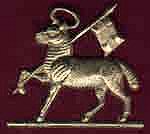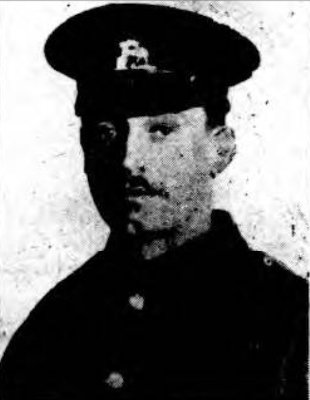LEATHERHEAD WAR MEMORIALS - WWI
Private Ernest Henry Friday
2nd Bn. The Queen's (Royal West Surrey Regiment)
Town Memorial P3.R2.C2.

Taken, Not Given
PteErnest H Friday
2nd Royal West Surrey Regt
Loos
Oct 28, 1915
Ernest Friday died of wounds, and the regimental records of the Queens also state that his second Christian name was Henry. (1)
According to these records, which confirmed that he was serving with the 2nd. Bn. of his Regiment, he was born in Leatherhead, and, like so many of the Queens he enlisted at Guildford.
According to his unit's War Diary, on the 28th of October at 1915, the “whole battalion was in gauged in digging trenches, having been relieved in the trenches on 17th October by the 1st Bn. KOYLI [Kings Own Yorkshire Light Infantry].
However injuries occurred on two days previous to that event. On 3 October, three men were wounded, and on the 15th three more. The War Diary simply states “3 ORs wounded. One man to hospital. At night certain amount of bombing and shelling in the "Hohenzollern". The "Hohenzollern" was the infamous German redoubt which cost so many British lives at Loos.
Unfortunately it is not possible to identify with any degree of certainty when and Ernest Friday received his wounds. It may have been months earlier, but 3rd October is offered as a possibility.
Notes on sources
1. Regimental Records of The Queens, Regimental Museum, Clandon Park, Surrey.
2. File WO95–1664 War Diary of the 2nd Bn Queens, Public Record Office, Kew, Richmond.
Further research
PrivateFRIDAY, ERNEST HENRY
Service Number 4507
Died 28/10/1915
Aged 25
2nd Bn. The Queen's (Royal West Surrey Regiment)
Son of George and Eliza Friday, of Leatherhead; husband of Maude Mary Friday, of Ivy Cottages, Middle Rd., Leatherhead, Surrey.
INSCRIPTION
EVER IN OUR THOUGHTS FAITHFUL UNTO DEATH
Buried at ETAPLES MILITARY CEMETERY
Location: Pas de Calais, France
Cemetery/memorial reference: III. E. 17.
He enlisted at Guildford joining the Queen's (Royal West Surrey) Regiment with service number G/4507.
Dorking and Leatherhead Advertiser
Saturday 06 November 1915
ANOTHER LEATHERHEAD MAN KILLED
PTE E. H. FRIDAY DIES WOUNDS.
The war has claimed another Leatherhead man, notification having been received last week that Pte E. H. Friday, third son of Mr. and Mrs. G, Friday, of Glebe Cottages, Fairfield-road, Leatherhead, had died of wounds in hospital in France on October 27th.
| Dorking
and Leatherhead Advertiser Saturday 13 November 1915 PTE E. H. FRIDAY.
Last week we reported the death of Pte E. H. Friday, son of Mr. and Mrs. G. Friday, Glebe Cottages, Fairfield-road. Leatherhead. The photograph reproduced [above] did not reach us till this week. |
 Pte E.H. FRIDAY |
Surrey Mirror
Friday 31 December 1915
BRAVE SURREY MEN FALLEN IN THE WAR.
LEATHERHEAD AND DISTRICT.
Pte. E. H. Friday, 2nd Batt. R.W.S. Regiment (died October 27th from wounds received in action in France). Third son of Mr. and Mrs. G. Friday. Glebe Cottages, Fairfield-road, Leatherhead.
Leatherhead Parish Magazine, November 1915
...
Oct 27 [sic] 1915 Ernest Friday, 2nd Queen's W. Surrey, killed in action in Flanders [sic]
His life
Ernest Friday was born on 20 August 1890 and baptised on 19 October 1890 at St Mary & St Nicholas, the parish church of Leatherhead, Surrey.His father was George Friday b September 1861, baptised 10 November 1861 Fetcham, Surrey. He was the son of Charles Friday (1831-1896) and Anne Stovell (1835-1886).
His mother was Jane Elizabeth Friday née Ramsbotham, born 5 February 1863 Tostock, Suffolk.
They married on 11 July 1883 at St Martins, the parish church of Epsom.
Ernest's siblings were William George b 1893, Walter Frederick b 1887, Albert Harold b 1893, Cecil St Clare b 1898, and Elsie Muriel b 1901.
The 1911 Census, in which Ernest is described as a General Labourer, shows his wife of one year as Maude Friday, born Calne, Wiltshire.
Their son Leslie Ernest Henry Friday was born on 28 January 1911 and baptised at All Saints, Leatherhead, Surrey and their address was Middle Road, Fairfield, Leatherhead. Ernest 's occupation was Labourer.
Their daughters Maude Mary b 25 March 1913 and Gladys Elizabeth May b May 14 1914 were baptised at Leatherhead Parish Church on July 18 1915. The Fridays' address was Ivy Cottages, Middle Road, Leatherhead and Ernest was described as a Gardener (Soldier, Pte 2nd QW Surrey).
The 1911 Census, in which Ernest is described as a General Labourer, shows his wife of one year as Maude Friday. However, his Military Pension Record states Maude Mary as his unmarried wife. No marriage records have been found so far.
At the time of his death Maude was living at Ivy Cottages, Middle Road, Leatherhead, Surrey.
After the war
In 1925 Maude (or Maud), who had three young children, got married again, to Sidney J Penfold. Sidney was a brother of Leonard Penfold (with whom Ernest was up before the Epsom Petty Sessions in 1912 - see below), and Benjamin Penfold, both of whom, like Ernest Friday, did not return from WW1. Benjamin is also commemorated on the Epsom War Memorial.In the 1939 England & Wales Register Maude Mary Penfold, b 26 August 1881, was still at 16 Middle Road but was again a widow - Sidney Penfold had died in 1934. Maude's death at the age of 81 was registered in Surrey Mid Eastern District in October 1962.
Ernest is remembered on these memorials
Leatherhead Town Memorial
Leatherhead RBL Roll of Honour, Leatherhead Parish Church
Ladies War Shrine, Leatherhead Parish Church
Church Lads Brigade Memorial Tryptich, All Saints Leatherhead
Surrey in the Great War
Ernest's cousin Percy - From Young Offender to Volunteer Hero
Ernest's cousin Percy (their fathers George and Charles were
brothers) was a case of, as Lorraine Spindler put it in her book Leatherhead
and the Great War, 'From Young Offender to Volunteer Hero' ...
Percy Friday was born on 2 April 1895 to Charles and Helen Friday
who were both from long established Leatherhead families and living at 8
St John’s Terrace in 1911. The Census shows Charles and Helen had eight
children, but by 1911 only four were still living. Percy, like his
father, was a general labourer.
The Dorking and Leatherhead Advertiser of 17 August 1912
reported Percy’s appearance at the Epsom Petty Sessions for criminal
damage to the alder trees of Randalls Park and trespassing onto the
property of Mr A.H. Henderson. Percy had thrown doubt on his innocence
at the scene by claiming his name was Arthur Sayers of 5 Kings Lea,
Leatherhead.
Percy and his friend, Leonard
Godfrey Penfold, were discharged with a caution having
stated they were going to the river to bathe and found a bonfire of
alder trees already alight.
A month later, September 1912, Percy joined the 1st Battalion of the
East Surrey Regiment. When war broke out his medal roll shows he
embarked for France with the British Expeditionary Force on 16 August
1914, almost two years to the day after the Randalls Park incident. His
friend, Leonard, joined the 1st Battalion of the Queen’s (Royal West
Surrey) Regiment between February and July 1914, enlisting at Kingston.
Leonard went missing during the First Battle of the Ypres; his death is
recorded as 29 October 1914 and his
brother Benjamin died
on 13 September 1915. Both are commemorated on the Leatherhead War
Memorial. Their twin brothers, Sydney and Arthur, joined the Royal Field
Artillery together and both survived the war.
The Friday family, like many others across the nation, submitted Percy’s
letters home to the local newspaper; this seldom happened in the
national press for security reasons. Percy may well have seen his own
letter in the paper as local newspapers were available to the fighting
troops. In effect Percy and his fellow soldiers would take part in a
battle and then read about themselves a few days later. Soldiers also
learnt of the deaths of their family and friends from the newspapers;
Percy most likely discovered Leonard had gone missing from the
newspapers.
People at home were usually very keen to hear about what was happening
on the front lines, especially from those they knew. Percy would have
been limited by censorship and his own judgement on what relatives and
friends should be told about his experiences. His letter, dated 30
October 1914, was published in the 14 November 1914 edition of the Dorking
and Leatherhead Advertiser: